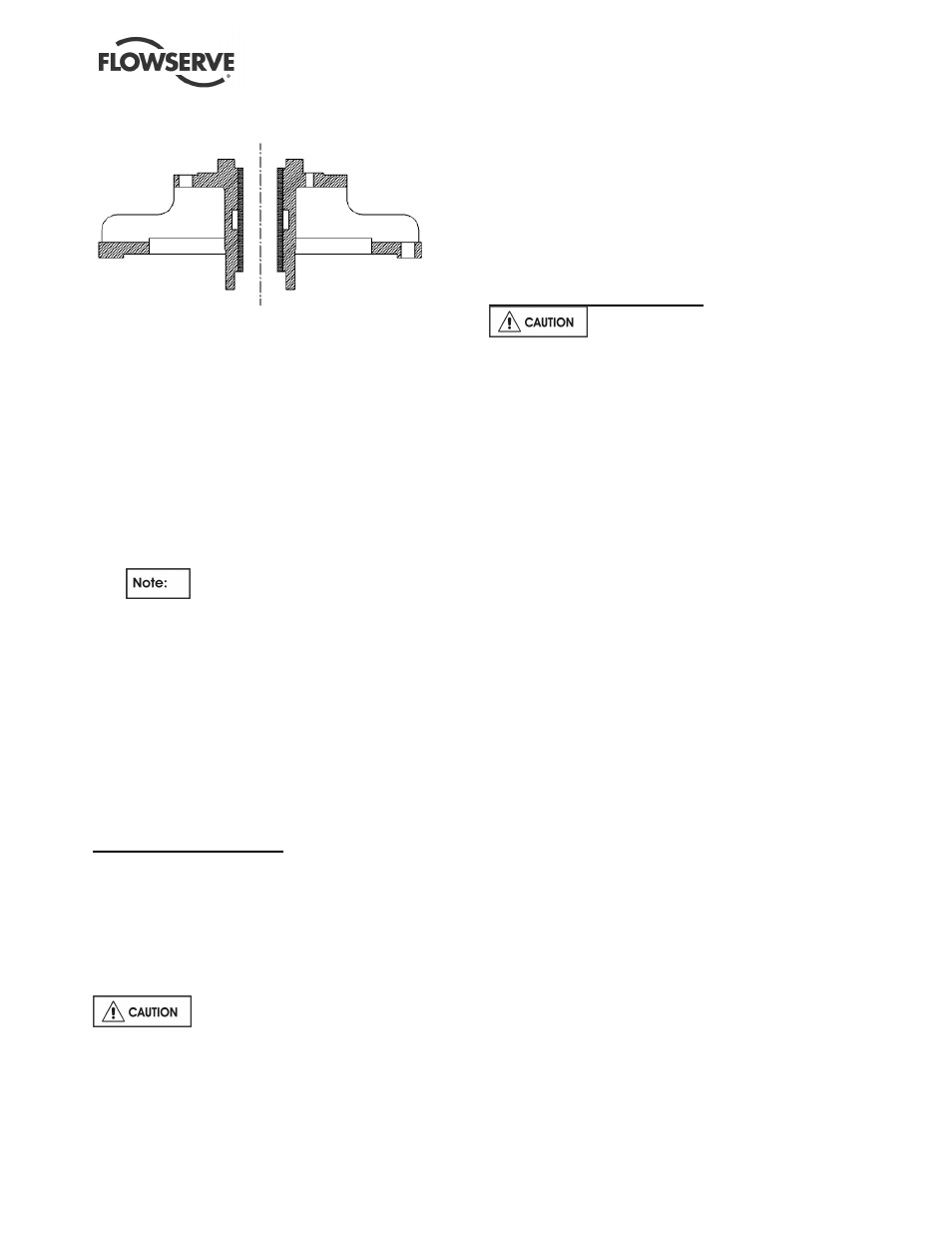Flowserve ESP3 User Manual
Page 47

ESP3 USER INSTRUCTIONS ENGLISH 26999943 08-11
Page 47 of 64
Figure 6-9 Adapter bearing
6.9.2 Assembling mounting plate, column(s),
adapter and shaft
If a shaft nose cone is available, the mounting plate,
column(s), intermediate bearing(s) and adapter may
be assembled prior to shaft insertion. If a nose cone
is not available, the pump must be built in section
over the shaft. Use of a shaft nose cone is
recommended.
a)
Standard and vapor tight construction:
connect the upper column [1341.1] to the
mounting plate [6130]. For Group 3, the upper
column and support head [3160] must be bolted
to the mounting plate at the same time.
In this configuration, the upper column
contains a lip seal [4310.2] which is installed with
the energizing spring down. Although installation
is more difficult, it is beneficial to install the lip seal
after shaft installation to prevent damage. Wrap
the shaft thread with Teflon tape to protect lip seal
from damage.
Vapor proof or pressurized construction:
replace the upper column gasket [4590.5] and
reconnect the upper column [1341.1] to the
mounting plate [6130]. For Group 3, the bearing
bracket [4310.2] must be bolted to the mounting
plate at the same time.
Assembly with nose cone
b)
If intermediate bearings are used, install the
bearing holder [3250] and intermediate column
[1341.2] and bolt them together. Repeat for
each section.
c)
Bolt the adapter [1340.1] back onto the last
column in the pump.
d)
Screw the shaft bullet onto the end of the shaft
[2100] at the impeller end.
Always insert the shaft from the
mounting plate side of the pump. Never insert it from
the adapter side because shaft threads may cause
damage to the internal bearings.
e)
The pump shaft [2100] should now be inserted
into the pump from the mounting plate side.
Standard and vapor tight construction require a
lip seal [4310.2] in the upper column. If the lip
seal is installed prior to the shaft, than ensure
the lip seal and shaft are lubricated to prevent
damage to the lip seal. The lip seal may be
installed after the shaft is slid into place, but
installation is more difficult (see section a) for
details). Fill the cavity between the lips ½ to
⅔
full
Assembly without nose cone
It is important that the shaft and columns
are well supported after the shaft is partially inserted as
bending in the shaft may occur.
b)
Insert the shaft from the motor side of the pump
through the starter column [1341.1] until the
shaft threads [for the thrust bearing - 3031] are
about 3 inches from the starter column
Standard and vapor tight construction require a
lip seal [4310.2] in the upper column. If the lip
seal is installed prior to the shaft, than ensure
the lip seal and shaft are lubricated to prevent
damage to the lip seal. The lip seal may be
installed at the end of this sequence, but
installation is more difficult (see section a) for
details).
c)
If intermediate bearing(s) are used, slide the
bearing holder [3250] onto the end of the shaft
[2100], followed by the column [1341.2] and bolt
together. Repeat for each section.
d)
Slide the adapter [1340.1] onto the shaft [2100]
and bolt to the column [1341.1] or [1341.2].
6.9.3 Cover, Impeller and Casing Installation
a)
Install the cover [1220] to the adapter [1340.1].
If applicable, hold the cover in place with cap
screws [6570.16].
b)
Install the impeller. Section 6.6 covers all
aspects of impeller installation. Install a new
gasket [4590.2], sleeve O-ring [4590.1] and
lubricate threads.
c)
Place a new gasket [4590.1] on the gasket face
of the cover [1220] and bolt the casing [1100] to
the adapter [1340.1]
6.9.4 Ball bearing/Adjusting Sleeve Assembly
Mounting of bearings must be done in a clean
environment. Thrust bearing life can be drastically
reduced if even very small foreign particles work their
way into the bearings. Wear clean gloves.
Bearings should be removed from their protective
packaging only immediately before assembly to limit
exposure to possible contamination. After removing
